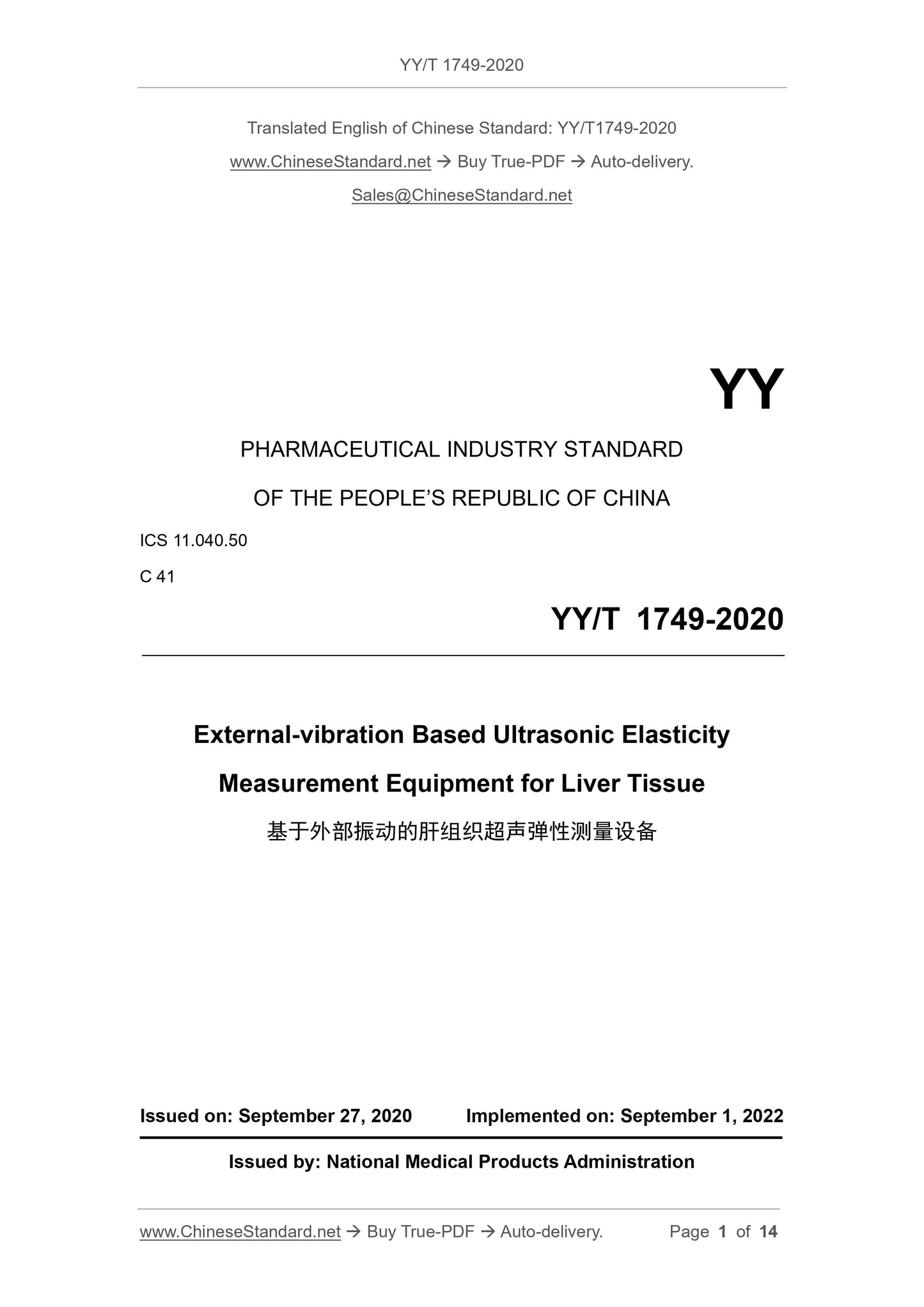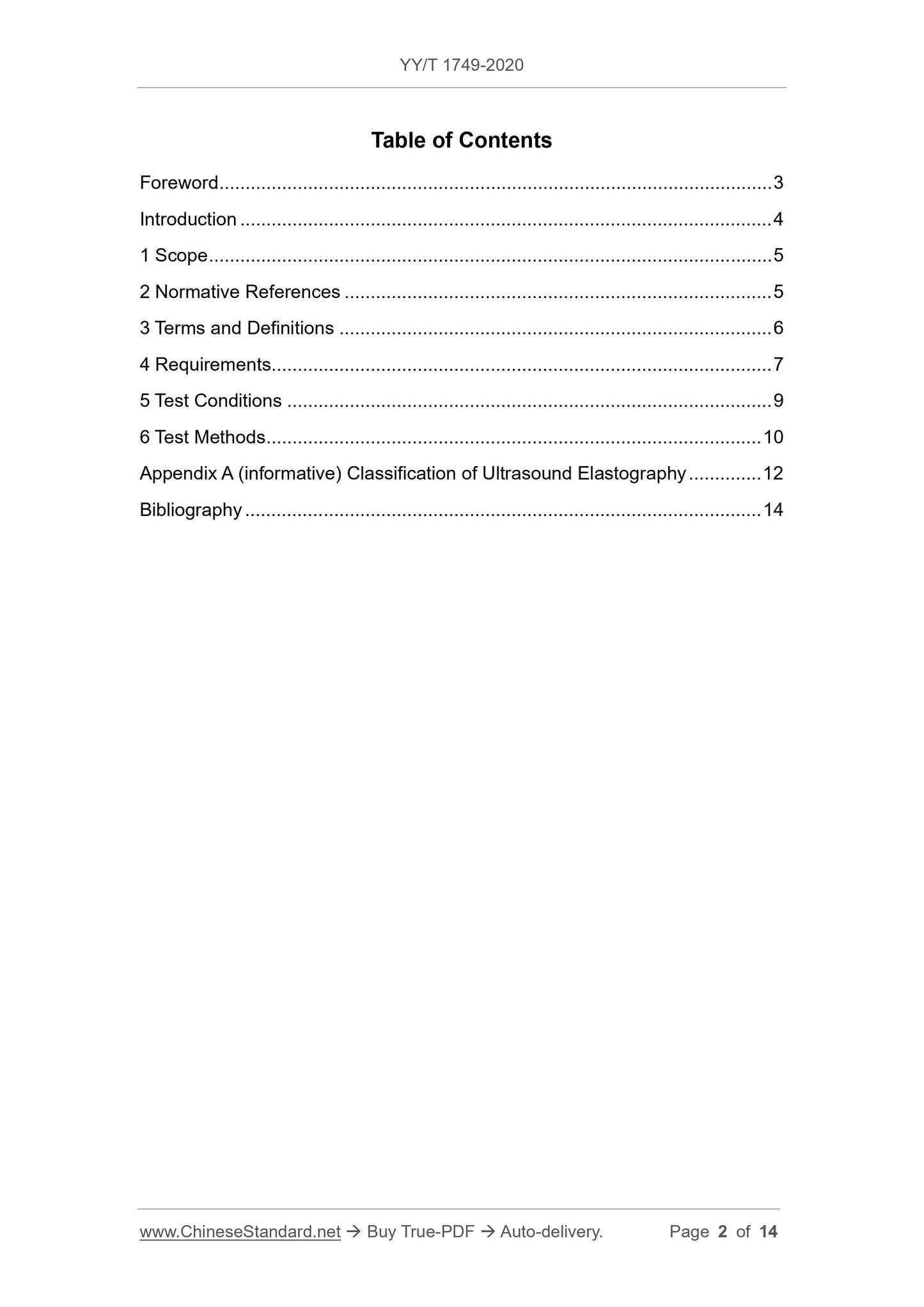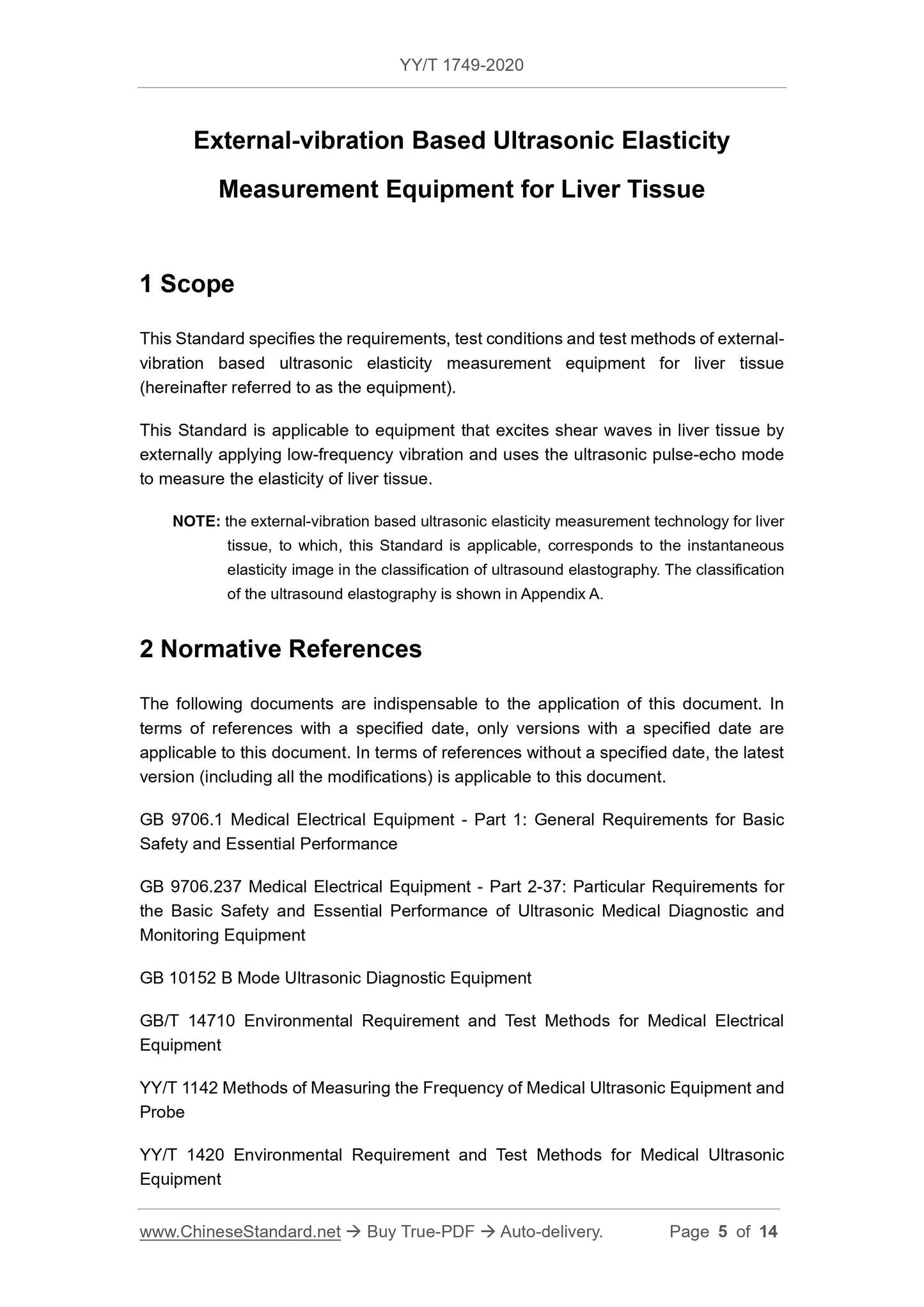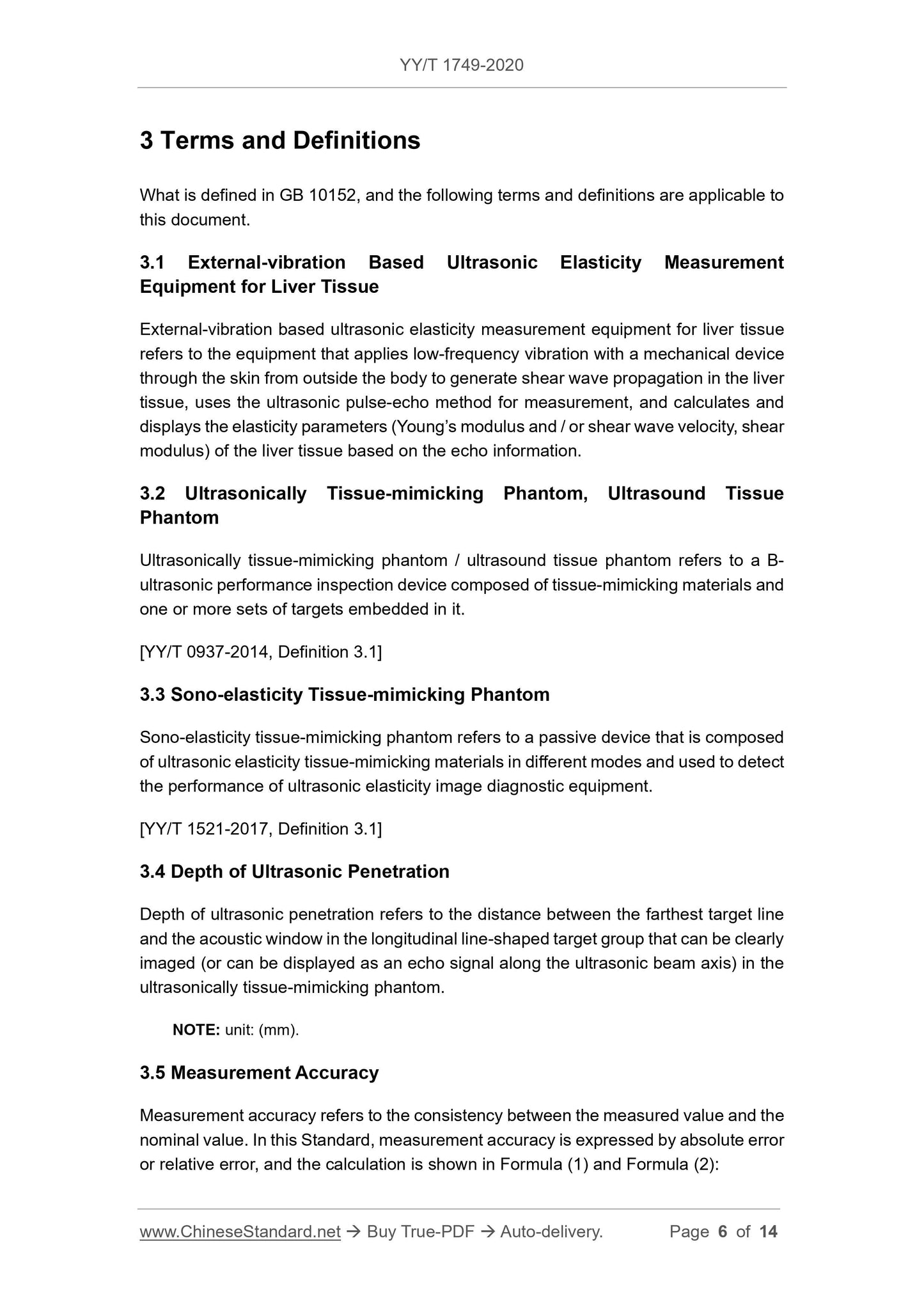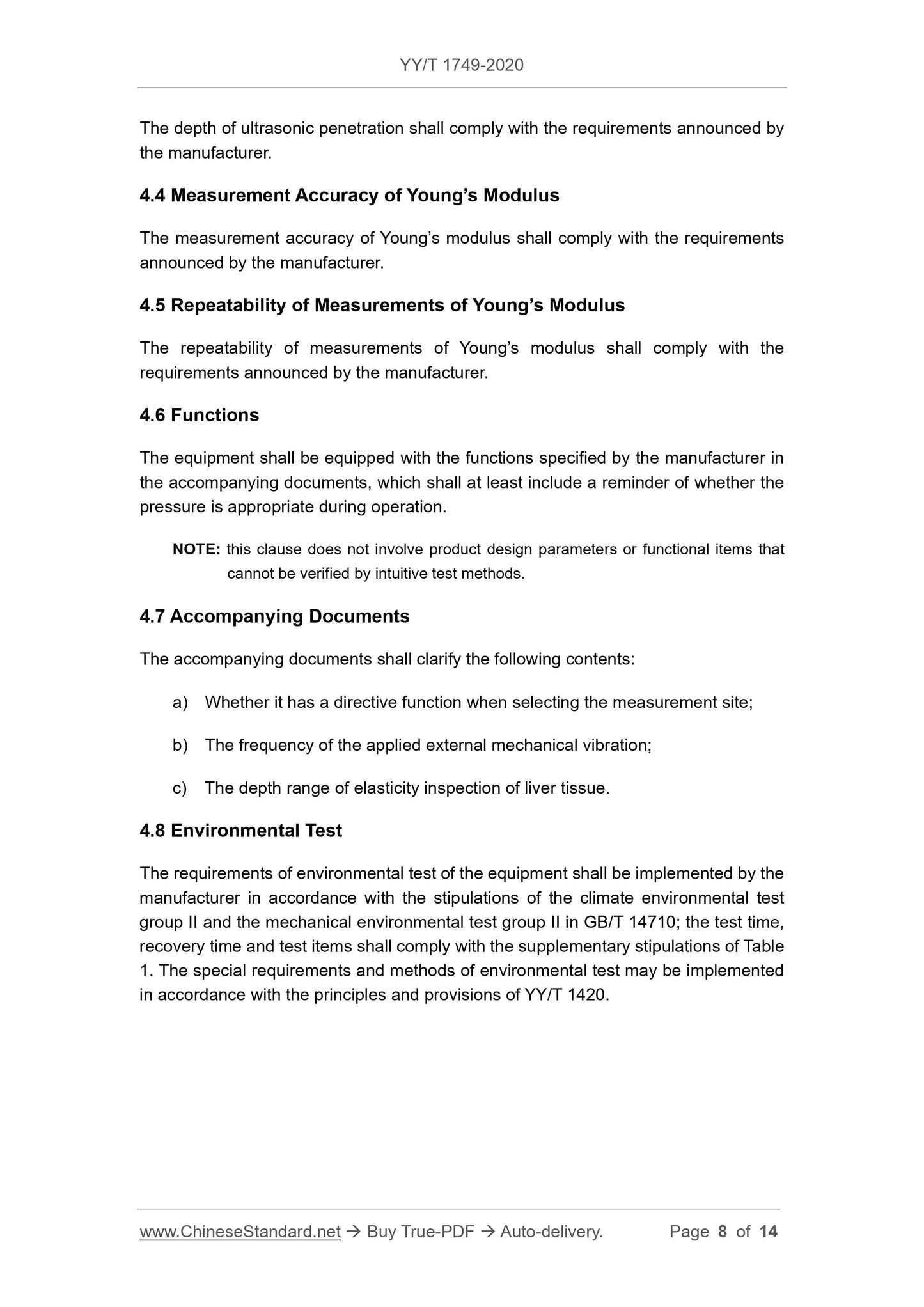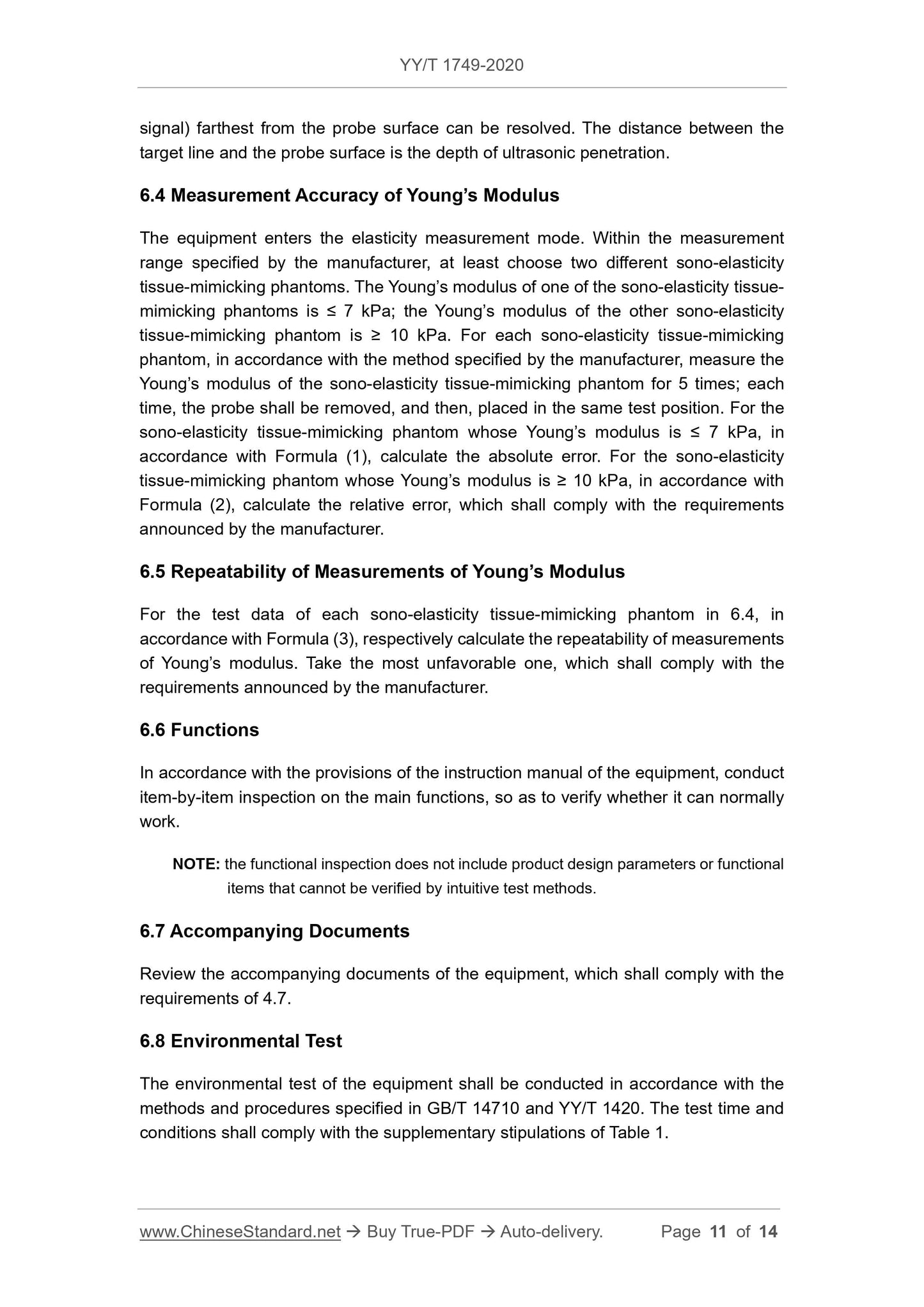1
/
of
6
www.ChineseStandard.us -- Field Test Asia Pte. Ltd.
YY/T 1749-2020 English PDF (YY/T1749-2020)
YY/T 1749-2020 English PDF (YY/T1749-2020)
Regular price
$185.00
Regular price
Sale price
$185.00
Unit price
/
per
Shipping calculated at checkout.
Couldn't load pickup availability
YY/T 1749-2020: External-vibration Based Ultrasonic Elasticity Measurement Equipment for Liver Tissue
Delivery: 9 seconds. Download (& Email) true-PDF + Invoice.
Get Quotation: Click YY/T 1749-2020 (Self-service in 1-minute)
Historical versions (Master-website): YY/T 1749-2020
Preview True-PDF (Reload/Scroll-down if blank)
YY/T 1749-2020
YY
PHARMACEUTICAL INDUSTRY STANDARD
OF THE PEOPLE’S REPUBLIC OF CHINA
ICS 11.040.50
C 41
External-vibration Based Ultrasonic Elasticity
Measurement Equipment for Liver Tissue
ISSUED ON: SEPTEMBER 27, 2020
IMPLEMENTED ON: SEPTEMBER 1, 2022
Issued by: National Medical Products Administration
Table of Contents
Foreword ... 3
Introduction ... 4
1 Scope ... 5
2 Normative References ... 5
3 Terms and Definitions ... 6
4 Requirements... 7
5 Test Conditions ... 9
6 Test Methods ... 10
Appendix A (informative) Classification of Ultrasound Elastography ... 12
Bibliography ... 14
External-vibration Based Ultrasonic Elasticity
Measurement Equipment for Liver Tissue
1 Scope
This Standard specifies the requirements, test conditions and test methods of external-
vibration based ultrasonic elasticity measurement equipment for liver tissue
(hereinafter referred to as the equipment).
This Standard is applicable to equipment that excites shear waves in liver tissue by
externally applying low-frequency vibration and uses the ultrasonic pulse-echo mode
to measure the elasticity of liver tissue.
NOTE: the external-vibration based ultrasonic elasticity measurement technology for liver
tissue, to which, this Standard is applicable, corresponds to the instantaneous
elasticity image in the classification of ultrasound elastography. The classification
of the ultrasound elastography is shown in Appendix A.
2 Normative References
The following documents are indispensable to the application of this document. In
terms of references with a specified date, only versions with a specified date are
applicable to this document. In terms of references without a specified date, the latest
version (including all the modifications) is applicable to this document.
GB 9706.1 Medical Electrical Equipment - Part 1: General Requirements for Basic
Safety and Essential Performance
GB 9706.237 Medical Electrical Equipment - Part 2-37: Particular Requirements for
the Basic Safety and Essential Performance of Ultrasonic Medical Diagnostic and
Monitoring Equipment
GB 10152 B Mode Ultrasonic Diagnostic Equipment
GB/T 14710 Environmental Requirement and Test Methods for Medical Electrical
Equipment
YY/T 1142 Methods of Measuring the Frequency of Medical Ultrasonic Equipment and
Probe
YY/T 1420 Environmental Requirement and Test Methods for Medical Ultrasonic
Equipment
3 Terms and Definitions
What is defined in GB 10152, and the following terms and definitions are applicable to
this document.
3.1 External-vibration Based Ultrasonic Elasticity Measurement
Equipment for Liver Tissue
External-vibration based ultrasonic elasticity measurement equipment for liver tissue
refers to the equipment that applies low-frequency vibration with a mechanical device
through the skin from outside the body to generate shear wave propagation in the liver
tissue, uses the ultrasonic pulse-echo method for measurement, and calculates and
displays the elasticity parameters (Young’s modulus and / or shear wave velocity, shear
modulus) of the liver tissue based on the echo information.
3.2 Ultrasonically Tissue-mimicking Phantom, Ultrasound Tissue
Phantom
Ultrasonically tissue-mimicking phantom / ultrasound tissue phantom refers to a B-
ultrasonic performance inspection device composed of tissue-mimicking materials and
one or more sets of targets embedded in it.
[YY/T 0937-2014, Definition 3.1]
3.3 Sono-elasticity Tissue-mimicking Phantom
Sono-elasticity tissue-mimicking phantom refers to a passive device that is composed
of ultrasonic elasticity tissue-mimicking materials in different modes and used to detect
the performance of ultrasonic elasticity image diagnostic equipment.
[YY/T 1521-2017, Definition 3.1]
3.4 Depth of Ultrasonic Penetration
Depth of ultrasonic penetration refers to the distance between the farthest target line
and the acoustic window in the longitudinal line-shaped target group that can be clearly
imaged (or can be displayed as an echo signal along the ultrasonic beam axis) in the
ultrasonically tissue-mimicking phantom.
NOTE: unit: (mm).
3.5 Measurement Accuracy
Measurement accuracy refers to the consistency between the measured value and the
nominal value. In this Standard, measurement accuracy is expressed by absolute error
or relative error, and the calculation is shown in Formula (1) and Formula (2):
The depth of ultrasonic penetration shall comply with the requirements announced by
the manufacturer.
4.4 Measurement Accuracy of Young’s Modulus
The measurement accuracy of Young’s modulus shall comply with the requirements
announced by the manufacturer.
4.5 Repeatability of Measurements of Young’s Modulus
The repeatability of measurements of Young’s modulus shall comply with the
requirements announced by the manufacturer.
4.6 Functions
The equipment shall be equipped with the functions specified by the manufacturer in
the accompanying documents, which shall at least include a reminder of whether the
pressure is appropriate during operation.
NOTE: this clause does not involve product design parameters or functional items that
cannot be verified by intuitive test methods.
4.7 Accompanying Documents
The accompanying documents shall clarify the following contents:
a) Whether it has a directive function when selecting the measurement site;
b) The frequency of the applied external mechanical vibration;
c) The depth range of elasticity inspection of liver tissue.
4.8 Environmental Test
The requirements of environmental test of the equipment shall be implemented by the
manufacturer in accordance with the stipulations of the climate environmental test
group II and the mechanical environmental test group II in GB/T 14710; the test time,
recovery time and test items shall comply with the supplementary stipulations of Table
1. The special requirements and methods of environmental test may be implemented
in accordance with the principles and provisions of YY/T 1420.
signal) farthest from the probe surface can be resolved. The distance between the
target line and the probe surface is the depth of ultrasonic penetration.
6.4 Measurement Accuracy of Young’s Modulus
The equipment enters the elasticity measurement mode. Within the measurement
range specified by the manufacturer, at least choose two different sono-elasticity
tissue-mimicking phantoms. The Young’s modulus of one of the sono-elasticity tissue-
mimicking phantoms is ≤ 7 kPa; the Young’s modulus of the other sono-elasticity
tissue-mimicking phantom is ≥ 10 kPa. For each sono-elasticity tissue-mimicking
phantom, in accordance with the method specified by the manufacturer, measure the
Young’s modulus of the sono-elasticity tissue-mimicking phantom for 5 times; each
time, the probe shall be removed, and then, placed in the same test position. For the
sono-elasticity tissue-mimicking phantom whose Young’s modulus is ≤ 7 kPa, in
accordance with Formula (1), calculate the absolute error. For the sono-elasticity
tissue-mimicking phantom whose Young’s modulus is ≥ 10 kPa, in accordance with
Formula (2), calculate the relative error, which shall comply with the requirements
announced by the manufacturer.
6.5 Repeatability of Measurements of Young’s Modulus
For the test data of each sono-elasticity tissue-mimicking phantom in 6.4, in
accordance with Formula (3), respectively calculate the repeatability of measurements
of Young’s modulus. Take the most unfavorable one, which shall comply with the
requirements announced by the manufacturer.
6.6 Functions
In accordance with the provisions of the instruction manual of the equipment, conduct
item-by-item inspection on the main functions, so as to verify whether it can normally
work.
NOTE: the functional inspection does not include product design parameters or functional
items that cannot be verified by intuitive test methods.
6.7 Accompanying Documents
Review the accompanying documents of the equipment, which shall comply with the
requirements of 4.7.
6.8 Environmental Test
The environmental test of the equipment shall be conducted in accordance with the
methods and procedures specified in GB/T 14710 and YY/T 1420. The test time and
conditions shall comply with the supplementary stipulations of Table 1.
YY/T 1749-2020
YY
PHARMACEUTICAL INDUSTRY STANDARD
OF THE PEOPLE’S REPUBLIC OF CHINA
ICS 11.040.50
C 41
External-vibration Based Ultrasonic Elasticity
Measurement Equipment for Liver Tissue
ISSUED ON: SEPTEMBER 27, 2020
IMPLEMENTED ON: SEPTEMBER 1, 2022
Issued by: National Medical Products Administration
Table of Contents
Foreword ... 3
Introduction ... 4
1 Scope ... 5
2 Normative References ... 5
3 Terms and Definitions ... 6
4 Requirements... 7
5 Test Conditions ... 9
6 Test Methods ... 10
Appendix A (informative) Classification of Ultrasound Elastography ... 12
Bibliography ... 14
External-vibration Based Ultrasonic Elasticity
Measurement Equipment for Liver Tissue
1 Scope
This Standard specifies the requirements, test conditions and test methods of external-
vibration based ultrasonic elasticity measurement equipment for liver tissue
(hereinafter referred to as the equipment).
This Standard is applicable to equipment that excites shear waves in liver tissue by
externally applying low-frequency vibration and uses the ultrasonic pulse-echo mode
to measure the elasticity of liver tissue.
NOTE: the external-vibration based ultrasonic elasticity measurement technology for liver
tissue, to which, this Standard is applicable, corresponds to the instantaneous
elasticity image in the classification of ultrasound elastography. The classification
of the ultrasound elastography is shown in Appendix A.
2 Normative References
The following documents are indispensable to the application of this document. In
terms of references with a specified date, only versions with a specified date are
applicable to this document. In terms of references without a specified date, the latest
version (including all the modifications) is applicable to this document.
GB 9706.1 Medical Electrical Equipment - Part 1: General Requirements for Basic
Safety and Essential Performance
GB 9706.237 Medical Electrical Equipment - Part 2-37: Particular Requirements for
the Basic Safety and Essential Performance of Ultrasonic Medical Diagnostic and
Monitoring Equipment
GB 10152 B Mode Ultrasonic Diagnostic Equipment
GB/T 14710 Environmental Requirement and Test Methods for Medical Electrical
Equipment
YY/T 1142 Methods of Measuring the Frequency of Medical Ultrasonic Equipment and
Probe
YY/T 1420 Environmental Requirement and Test Methods for Medical Ultrasonic
Equipment
3 Terms and Definitions
What is defined in GB 10152, and the following terms and definitions are applicable to
this document.
3.1 External-vibration Based Ultrasonic Elasticity Measurement
Equipment for Liver Tissue
External-vibration based ultrasonic elasticity measurement equipment for liver tissue
refers to the equipment that applies low-frequency vibration with a mechanical device
through the skin from outside the body to generate shear wave propagation in the liver
tissue, uses the ultrasonic pulse-echo method for measurement, and calculates and
displays the elasticity parameters (Young’s modulus and / or shear wave velocity, shear
modulus) of the liver tissue based on the echo information.
3.2 Ultrasonically Tissue-mimicking Phantom, Ultrasound Tissue
Phantom
Ultrasonically tissue-mimicking phantom / ultrasound tissue phantom refers to a B-
ultrasonic performance inspection device composed of tissue-mimicking materials and
one or more sets of targets embedded in it.
[YY/T 0937-2014, Definition 3.1]
3.3 Sono-elasticity Tissue-mimicking Phantom
Sono-elasticity tissue-mimicking phantom refers to a passive device that is composed
of ultrasonic elasticity tissue-mimicking materials in different modes and used to detect
the performance of ultrasonic elasticity image diagnostic equipment.
[YY/T 1521-2017, Definition 3.1]
3.4 Depth of Ultrasonic Penetration
Depth of ultrasonic penetration refers to the distance between the farthest target line
and the acoustic window in the longitudinal line-shaped target group that can be clearly
imaged (or can be displayed as an echo signal along the ultrasonic beam axis) in the
ultrasonically tissue-mimicking phantom.
NOTE: unit: (mm).
3.5 Measurement Accuracy
Measurement accuracy refers to the consistency between the measured value and the
nominal value. In this Standard, measurement accuracy is expressed by absolute error
or relative error, and the calculation is shown in Formula (1) and Formula (2):
The depth of ultrasonic penetration shall comply with the requirements announced by
the manufacturer.
4.4 Measurement Accuracy of Young’s Modulus
The measurement accuracy of Young’s modulus shall comply with the requirements
announced by the manufacturer.
4.5 Repeatability of Measurements of Young’s Modulus
The repeatability of measurements of Young’s modulus shall comply with the
requirements announced by the manufacturer.
4.6 Functions
The equipment shall be equipped with the functions specified by the manufacturer in
the accompanying documents, which shall at least include a reminder of whether the
pressure is appropriate during operation.
NOTE: this clause does not involve product design parameters or functional items that
cannot be verified by intuitive test methods.
4.7 Accompanying Documents
The accompanying documents shall clarify the following contents:
a) Whether it has a directive function when selecting the measurement site;
b) The frequency of the applied external mechanical vibration;
c) The depth range of elasticity inspection of liver tissue.
4.8 Environmental Test
The requirements of environmental test of the equipment shall be implemented by the
manufacture...
Delivery: 9 seconds. Download (& Email) true-PDF + Invoice.
Get Quotation: Click YY/T 1749-2020 (Self-service in 1-minute)
Historical versions (Master-website): YY/T 1749-2020
Preview True-PDF (Reload/Scroll-down if blank)
YY/T 1749-2020
YY
PHARMACEUTICAL INDUSTRY STANDARD
OF THE PEOPLE’S REPUBLIC OF CHINA
ICS 11.040.50
C 41
External-vibration Based Ultrasonic Elasticity
Measurement Equipment for Liver Tissue
ISSUED ON: SEPTEMBER 27, 2020
IMPLEMENTED ON: SEPTEMBER 1, 2022
Issued by: National Medical Products Administration
Table of Contents
Foreword ... 3
Introduction ... 4
1 Scope ... 5
2 Normative References ... 5
3 Terms and Definitions ... 6
4 Requirements... 7
5 Test Conditions ... 9
6 Test Methods ... 10
Appendix A (informative) Classification of Ultrasound Elastography ... 12
Bibliography ... 14
External-vibration Based Ultrasonic Elasticity
Measurement Equipment for Liver Tissue
1 Scope
This Standard specifies the requirements, test conditions and test methods of external-
vibration based ultrasonic elasticity measurement equipment for liver tissue
(hereinafter referred to as the equipment).
This Standard is applicable to equipment that excites shear waves in liver tissue by
externally applying low-frequency vibration and uses the ultrasonic pulse-echo mode
to measure the elasticity of liver tissue.
NOTE: the external-vibration based ultrasonic elasticity measurement technology for liver
tissue, to which, this Standard is applicable, corresponds to the instantaneous
elasticity image in the classification of ultrasound elastography. The classification
of the ultrasound elastography is shown in Appendix A.
2 Normative References
The following documents are indispensable to the application of this document. In
terms of references with a specified date, only versions with a specified date are
applicable to this document. In terms of references without a specified date, the latest
version (including all the modifications) is applicable to this document.
GB 9706.1 Medical Electrical Equipment - Part 1: General Requirements for Basic
Safety and Essential Performance
GB 9706.237 Medical Electrical Equipment - Part 2-37: Particular Requirements for
the Basic Safety and Essential Performance of Ultrasonic Medical Diagnostic and
Monitoring Equipment
GB 10152 B Mode Ultrasonic Diagnostic Equipment
GB/T 14710 Environmental Requirement and Test Methods for Medical Electrical
Equipment
YY/T 1142 Methods of Measuring the Frequency of Medical Ultrasonic Equipment and
Probe
YY/T 1420 Environmental Requirement and Test Methods for Medical Ultrasonic
Equipment
3 Terms and Definitions
What is defined in GB 10152, and the following terms and definitions are applicable to
this document.
3.1 External-vibration Based Ultrasonic Elasticity Measurement
Equipment for Liver Tissue
External-vibration based ultrasonic elasticity measurement equipment for liver tissue
refers to the equipment that applies low-frequency vibration with a mechanical device
through the skin from outside the body to generate shear wave propagation in the liver
tissue, uses the ultrasonic pulse-echo method for measurement, and calculates and
displays the elasticity parameters (Young’s modulus and / or shear wave velocity, shear
modulus) of the liver tissue based on the echo information.
3.2 Ultrasonically Tissue-mimicking Phantom, Ultrasound Tissue
Phantom
Ultrasonically tissue-mimicking phantom / ultrasound tissue phantom refers to a B-
ultrasonic performance inspection device composed of tissue-mimicking materials and
one or more sets of targets embedded in it.
[YY/T 0937-2014, Definition 3.1]
3.3 Sono-elasticity Tissue-mimicking Phantom
Sono-elasticity tissue-mimicking phantom refers to a passive device that is composed
of ultrasonic elasticity tissue-mimicking materials in different modes and used to detect
the performance of ultrasonic elasticity image diagnostic equipment.
[YY/T 1521-2017, Definition 3.1]
3.4 Depth of Ultrasonic Penetration
Depth of ultrasonic penetration refers to the distance between the farthest target line
and the acoustic window in the longitudinal line-shaped target group that can be clearly
imaged (or can be displayed as an echo signal along the ultrasonic beam axis) in the
ultrasonically tissue-mimicking phantom.
NOTE: unit: (mm).
3.5 Measurement Accuracy
Measurement accuracy refers to the consistency between the measured value and the
nominal value. In this Standard, measurement accuracy is expressed by absolute error
or relative error, and the calculation is shown in Formula (1) and Formula (2):
The depth of ultrasonic penetration shall comply with the requirements announced by
the manufacturer.
4.4 Measurement Accuracy of Young’s Modulus
The measurement accuracy of Young’s modulus shall comply with the requirements
announced by the manufacturer.
4.5 Repeatability of Measurements of Young’s Modulus
The repeatability of measurements of Young’s modulus shall comply with the
requirements announced by the manufacturer.
4.6 Functions
The equipment shall be equipped with the functions specified by the manufacturer in
the accompanying documents, which shall at least include a reminder of whether the
pressure is appropriate during operation.
NOTE: this clause does not involve product design parameters or functional items that
cannot be verified by intuitive test methods.
4.7 Accompanying Documents
The accompanying documents shall clarify the following contents:
a) Whether it has a directive function when selecting the measurement site;
b) The frequency of the applied external mechanical vibration;
c) The depth range of elasticity inspection of liver tissue.
4.8 Environmental Test
The requirements of environmental test of the equipment shall be implemented by the
manufacturer in accordance with the stipulations of the climate environmental test
group II and the mechanical environmental test group II in GB/T 14710; the test time,
recovery time and test items shall comply with the supplementary stipulations of Table
1. The special requirements and methods of environmental test may be implemented
in accordance with the principles and provisions of YY/T 1420.
signal) farthest from the probe surface can be resolved. The distance between the
target line and the probe surface is the depth of ultrasonic penetration.
6.4 Measurement Accuracy of Young’s Modulus
The equipment enters the elasticity measurement mode. Within the measurement
range specified by the manufacturer, at least choose two different sono-elasticity
tissue-mimicking phantoms. The Young’s modulus of one of the sono-elasticity tissue-
mimicking phantoms is ≤ 7 kPa; the Young’s modulus of the other sono-elasticity
tissue-mimicking phantom is ≥ 10 kPa. For each sono-elasticity tissue-mimicking
phantom, in accordance with the method specified by the manufacturer, measure the
Young’s modulus of the sono-elasticity tissue-mimicking phantom for 5 times; each
time, the probe shall be removed, and then, placed in the same test position. For the
sono-elasticity tissue-mimicking phantom whose Young’s modulus is ≤ 7 kPa, in
accordance with Formula (1), calculate the absolute error. For the sono-elasticity
tissue-mimicking phantom whose Young’s modulus is ≥ 10 kPa, in accordance with
Formula (2), calculate the relative error, which shall comply with the requirements
announced by the manufacturer.
6.5 Repeatability of Measurements of Young’s Modulus
For the test data of each sono-elasticity tissue-mimicking phantom in 6.4, in
accordance with Formula (3), respectively calculate the repeatability of measurements
of Young’s modulus. Take the most unfavorable one, which shall comply with the
requirements announced by the manufacturer.
6.6 Functions
In accordance with the provisions of the instruction manual of the equipment, conduct
item-by-item inspection on the main functions, so as to verify whether it can normally
work.
NOTE: the functional inspection does not include product design parameters or functional
items that cannot be verified by intuitive test methods.
6.7 Accompanying Documents
Review the accompanying documents of the equipment, which shall comply with the
requirements of 4.7.
6.8 Environmental Test
The environmental test of the equipment shall be conducted in accordance with the
methods and procedures specified in GB/T 14710 and YY/T 1420. The test time and
conditions shall comply with the supplementary stipulations of Table 1.
YY/T 1749-2020
YY
PHARMACEUTICAL INDUSTRY STANDARD
OF THE PEOPLE’S REPUBLIC OF CHINA
ICS 11.040.50
C 41
External-vibration Based Ultrasonic Elasticity
Measurement Equipment for Liver Tissue
ISSUED ON: SEPTEMBER 27, 2020
IMPLEMENTED ON: SEPTEMBER 1, 2022
Issued by: National Medical Products Administration
Table of Contents
Foreword ... 3
Introduction ... 4
1 Scope ... 5
2 Normative References ... 5
3 Terms and Definitions ... 6
4 Requirements... 7
5 Test Conditions ... 9
6 Test Methods ... 10
Appendix A (informative) Classification of Ultrasound Elastography ... 12
Bibliography ... 14
External-vibration Based Ultrasonic Elasticity
Measurement Equipment for Liver Tissue
1 Scope
This Standard specifies the requirements, test conditions and test methods of external-
vibration based ultrasonic elasticity measurement equipment for liver tissue
(hereinafter referred to as the equipment).
This Standard is applicable to equipment that excites shear waves in liver tissue by
externally applying low-frequency vibration and uses the ultrasonic pulse-echo mode
to measure the elasticity of liver tissue.
NOTE: the external-vibration based ultrasonic elasticity measurement technology for liver
tissue, to which, this Standard is applicable, corresponds to the instantaneous
elasticity image in the classification of ultrasound elastography. The classification
of the ultrasound elastography is shown in Appendix A.
2 Normative References
The following documents are indispensable to the application of this document. In
terms of references with a specified date, only versions with a specified date are
applicable to this document. In terms of references without a specified date, the latest
version (including all the modifications) is applicable to this document.
GB 9706.1 Medical Electrical Equipment - Part 1: General Requirements for Basic
Safety and Essential Performance
GB 9706.237 Medical Electrical Equipment - Part 2-37: Particular Requirements for
the Basic Safety and Essential Performance of Ultrasonic Medical Diagnostic and
Monitoring Equipment
GB 10152 B Mode Ultrasonic Diagnostic Equipment
GB/T 14710 Environmental Requirement and Test Methods for Medical Electrical
Equipment
YY/T 1142 Methods of Measuring the Frequency of Medical Ultrasonic Equipment and
Probe
YY/T 1420 Environmental Requirement and Test Methods for Medical Ultrasonic
Equipment
3 Terms and Definitions
What is defined in GB 10152, and the following terms and definitions are applicable to
this document.
3.1 External-vibration Based Ultrasonic Elasticity Measurement
Equipment for Liver Tissue
External-vibration based ultrasonic elasticity measurement equipment for liver tissue
refers to the equipment that applies low-frequency vibration with a mechanical device
through the skin from outside the body to generate shear wave propagation in the liver
tissue, uses the ultrasonic pulse-echo method for measurement, and calculates and
displays the elasticity parameters (Young’s modulus and / or shear wave velocity, shear
modulus) of the liver tissue based on the echo information.
3.2 Ultrasonically Tissue-mimicking Phantom, Ultrasound Tissue
Phantom
Ultrasonically tissue-mimicking phantom / ultrasound tissue phantom refers to a B-
ultrasonic performance inspection device composed of tissue-mimicking materials and
one or more sets of targets embedded in it.
[YY/T 0937-2014, Definition 3.1]
3.3 Sono-elasticity Tissue-mimicking Phantom
Sono-elasticity tissue-mimicking phantom refers to a passive device that is composed
of ultrasonic elasticity tissue-mimicking materials in different modes and used to detect
the performance of ultrasonic elasticity image diagnostic equipment.
[YY/T 1521-2017, Definition 3.1]
3.4 Depth of Ultrasonic Penetration
Depth of ultrasonic penetration refers to the distance between the farthest target line
and the acoustic window in the longitudinal line-shaped target group that can be clearly
imaged (or can be displayed as an echo signal along the ultrasonic beam axis) in the
ultrasonically tissue-mimicking phantom.
NOTE: unit: (mm).
3.5 Measurement Accuracy
Measurement accuracy refers to the consistency between the measured value and the
nominal value. In this Standard, measurement accuracy is expressed by absolute error
or relative error, and the calculation is shown in Formula (1) and Formula (2):
The depth of ultrasonic penetration shall comply with the requirements announced by
the manufacturer.
4.4 Measurement Accuracy of Young’s Modulus
The measurement accuracy of Young’s modulus shall comply with the requirements
announced by the manufacturer.
4.5 Repeatability of Measurements of Young’s Modulus
The repeatability of measurements of Young’s modulus shall comply with the
requirements announced by the manufacturer.
4.6 Functions
The equipment shall be equipped with the functions specified by the manufacturer in
the accompanying documents, which shall at least include a reminder of whether the
pressure is appropriate during operation.
NOTE: this clause does not involve product design parameters or functional items that
cannot be verified by intuitive test methods.
4.7 Accompanying Documents
The accompanying documents shall clarify the following contents:
a) Whether it has a directive function when selecting the measurement site;
b) The frequency of the applied external mechanical vibration;
c) The depth range of elasticity inspection of liver tissue.
4.8 Environmental Test
The requirements of environmental test of the equipment shall be implemented by the
manufacture...
Share
